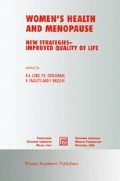Abstract
Reproduction is the forge of Darwinian evolution, and, reproductive fitness (positive adaptation for reproductive success) is directly and deeply ingrained in our genomic fabric. During the evolution of species from aquatic to terrestrial existence there was an internalization of the reproductive processes. This entailed the development of the contemporary urogenital tract through which retention of access from the exterior to the workings of the internalized reproductive processes occurs. The ancient excretory ducts were a natural venue for this since they were developed to provide an interface between the interior milieu and outside conditions [1]. Thus, even though sperm and eggs develop and fertilize inside the body there remains a pathway to and from the exterior in both male and female genital tracts. This pathway is used in males to emit sperm deeply in the vagina and in females to allow the timely ingress of sperm and egress of the fetus and placenta. Since there is an enormous difference between the size of the gametes and each fully developed fetus there must be mechanisms to allow the involved tissues to accommodate the changes in size without sustaining damage. This is part of the development of steroid-sensitive mechanisms such as the management of the interface between the interior of the genitourinary tract and the exterior that have evolved to foster reproduction. These include specialization of the epithelium, stroma, and immune system to maintain the integrity of the genital tract and its adaptation to injury, the response to the urogenital flora and the immune-privileged status of the genetically heterogeneous fetus, etc. Sex steroids that act primarily through nuclear receptors regulate most of these adaptations.
Access this chapter
Tax calculation will be finalised at checkout
Purchases are for personal use only
Preview
Unable to display preview. Download preview PDF.
References
Naftolin F, Lavy G, Palumbo A, DeCherney AH. Poissons, grenouilles, femmes et hommes: The appropriation and retention of archetypical systems for reproduction. Gynecol Endocrinol 1988;2:265–73.
Brincat M.P, Galea R. The skin and hormone replacement therapy. In: Brincat M, editor. Hormone replacement therapy and the skin. The Parthenon Publishing Group, 2001:1–17.
Lavy G, Whitten PL, Naftolin F. Introduction to vertebrate reproductive endocrinology. In: Pang PKT, Schreibman MP, editors. Vertebrate endocrinology: Fundamentals and biomedical implications. New York: Academic Press, 1991:1–22.
Nilsen J, Mor G, Naftolin F. Estrogen-regulated developmental neuronal apoptosis is determined by estrogen receptor subtype and the Fas/Fas ligand system. J Neurobiol 2000;43:64–78.
Song J, et al. Fas mediated endometrial remodeling. J Mol Human Reprod 2002; in press.
Mor G, Naftolin F. Oestrogen, menopause and the immune system. J British Menopause Society 1998;Sl:4–8.
Jeffrey J, Koob T. Endocrine control of collagen degradation in the uterus. In: Naftolin F, Stubblefleld P, editors. Dilatation of the uterine cervix. New York:Raven Press, 1980:135–45.
Cabrol D, Huszar G, Romero R, Naftolin F. Gestational changes in the rat uterine cervix: protein, collagen and glycosaminoglycan content. In: Ellwood D, Anderson A. The cervix in pregnancy and labour. Edinburgh, Scotland: Churchill Livingstone, 1981:34–56.
Saito Y, Sakamoto H, MacLusky NJ, Naftolin F. Gap junctions and myometrial steroid hormone receptors in pregnant and postpartum rats: A possible cellular basis for the progesterone withdrawal hypothesis. Am J Obstet Gynecol 1985 Mar 15; 151(6):805–12.
Garfield RE, et al. Control of myometrial contractility: role and regulation of gap functions. Oxf Rev Reprod Biol 1998;10:436–90.
Haluska GJ, et al. Progesterone receptor localization and isoforms in myometrium, deciduas and fetal membranes from rhesus macaques: Evidence for functional progesterone withdrawal at parturition. J Society for Gynecologic Investigation 2002, in press.
Liggens GC. Cervical ripening as an inflammatory reaction. In: Ellwood D, Anderson A, editors. The cervix in pregnancy and labour. Churchill Livingstone, 1981:1–9.
Huszar G, Cabrol D, Naftolin F. The relationship between myometrial and cervical functions in pregnancy and labor. In: Huszar G, editor. The physiology and biochemistry of the uterus in pregnancy and labor. Boca Raton: CRC Press, 1986:287–306.
Kleissl HP, VanderRest M, Naftolin F, Glorieux FH, DeLeon A. Collagen changes in the human uterine cervix at parturition. Am J Obstet Gynecol 1978;130(7):748–53.
Poole A. Proteinases of connective tissues. In: Naftolin F, Stubblefleld P, editors. Dilatation of the uterine cervix. New York:Raven Press, 1980:113–31.
Ivell R. This hormone has been relaxin’ too long! Science 2002 Jan 25;295(5555):637–38.
Muscat Baron Y. Corticosteroids, skin and hormone replacement therapy. In: Brincat M, editor. Hormone replacement therapy and the skin. The Parthenon Publishing Group, 2001:111–20.
Naftolin F, et al. An evolutionary perspective on the climacteric and menopause. J North American Menopause Society 1994;1(4):223–25.
Editor information
Editors and Affiliations
Rights and permissions
Copyright information
© 2002 Springer Science+Business Media New York
About this chapter
Cite this chapter
Naftolin, F., Rinaudo, P., Abushahin, F., Sze, E. (2002). Sex Steroid-Sensitive Reproductive Tissues in Women During Reproduction and Menopause. In: Lobo, R.A., Crosignani, P.G., Paoletti, R., Bruschi, F. (eds) Women’s Health and Menopause. Medical Science Symposia Series, vol 17. Springer, Boston, MA. https://doi.org/10.1007/978-1-4615-1061-1_12
Download citation
DOI: https://doi.org/10.1007/978-1-4615-1061-1_12
Publisher Name: Springer, Boston, MA
Print ISBN: 978-1-4613-5375-1
Online ISBN: 978-1-4615-1061-1
eBook Packages: Springer Book Archive

